Based on slides by Tamassa Goodrich

Graphs
CSE-250 Fall 2022 - Section B
Oct 5, 2022
Textbook: Ch. 15.3
Graphs
A graph is a pair $(V, E)$ where
- $V$ is a set of vertices
- $E$ is a set of vertex pairs called edges
- edges and vertices may also store data (labels)
Graphs
Example: A computer network
(edges store ping, nodes store addresses)

Edge Types
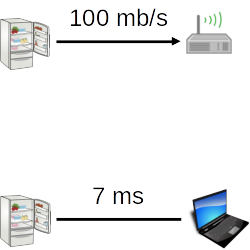
- Directed Edge (e.g., transmit bandwidth)
- Ordered pair of vertices $(u, v)$
- origin ($u$) → destination ($v$)
- Undirected edge (e.g., round-trip latency)
- Unordered pair of vertices $(u, v)$
- Directed Graph
- All edges are directed
- Undirected Graph
- All edges are undirected
Other Applications
- Transportation (Flight/Road/Rail Routing)
- Protein/Protein Interactions
- Social Networks
- Dependency Tracking (e.g., make)
- Taxonomies
Terminology
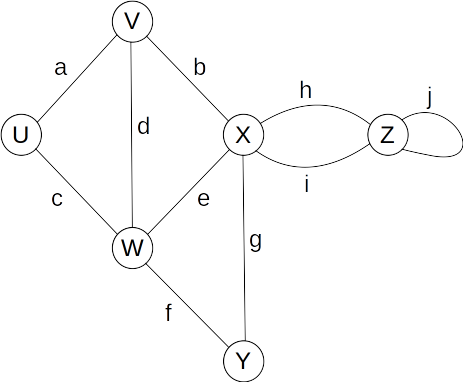
- Endpoints (end-vertices) of an edge
- U, V are the endpoints of a
- Edges incident on a vertex
- a, b, d are incident on V
- Adjacent Vertices
- U, V are adjacent
- Degree of a vertex (# of incident edges)
- X has degree 5
- Parallel Edges
- h, i are parallel
- Self-Loop
- j is a self-loop
- Simple Graph
- A graph without parallel edges or self-loops
Terminology

- Path
- Sequence of alternating vertices and edges
- begins with a vertex
- ends with a vertex
- each edge is preceded and followed by its endpoints
- Simple Path
- path such that all of its vertices and edges are distinct
- Examples
-
Terminology
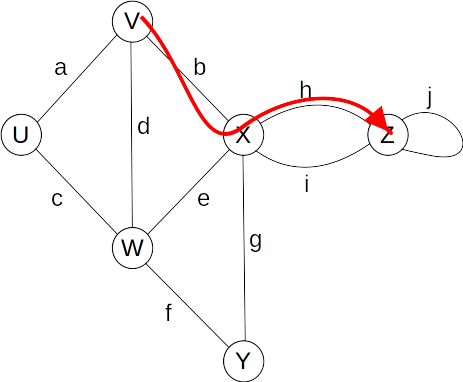
- Path
- Sequence of alternating vertices and edges
- begins with a vertex
- ends with a vertex
- each edge is preceded and followed by its endpoints
- Simple Path
- path such that all of its vertices and edges are distinct
- Examples
- V, b, X, h, Z is a simple path.
-
Terminology
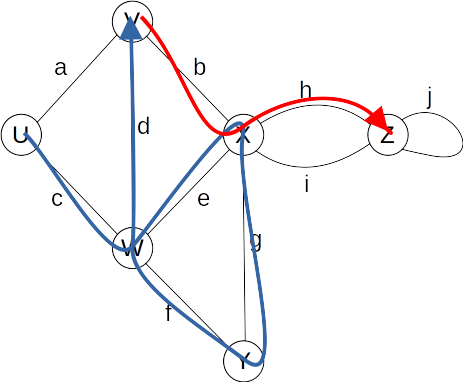
- Path
- Sequence of alternating vertices and edges
- Begins with a vertex
- Ends with a vertex
- Each edge is preceded and followed by its endpoints
- Simple Path
- Path such that all of its vertices and edges are distinct
- Examples
- V, b, X, h, Z is a simple path.
- U, c, W, e, X, g, Y, f, W, d, V is a path that is not simple.
Terminology

- Cycle
- Path that begins and ends with the same vertex
- Must contain at least one edge
- Simple Cycle
- Cycle such that all of its vertices and edges are distinct
- Examples
-
Terminology
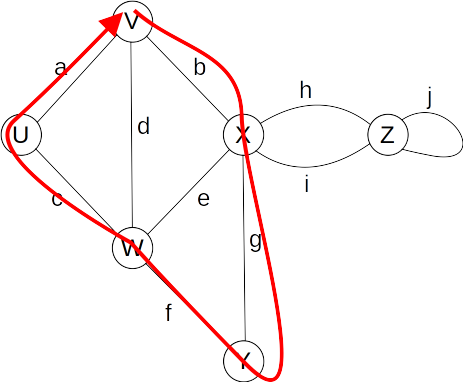
- Cycle
- Path that begins and ends with the same vertex
- Must contain at least one edge
- Simple Cycle
- Cycle such that all of its vertices and edges are distinct
- Examples
- V, b, X, g, Y, f, W, c, U, a, V is a simple cycle
-
Terminology
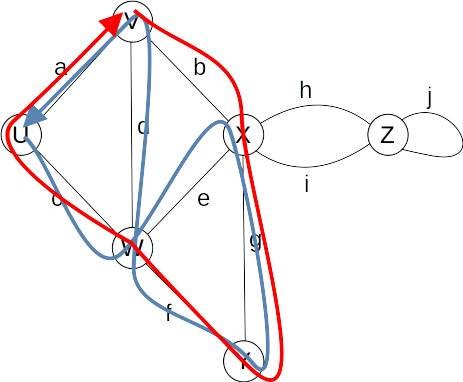
- Cycle
- Path that begins and ends with the same vertex
- Must contain at least one edge
- Simple Cycle
- Cycle such that all of its vertices and edges are distinct
- Examples
- V, b, X, g, Y, f, W, c, U, a, V is a simple cycle
- U, c, W, e, X, g, Y, f, W, d, V is a cycle that is not simple
Notation
- $n$
- The number of vertices
- $m$
- The number of edges
- $deg(v)$
- The degree of vertex $v$
Graph Properties
$$\sum_{v} deg(v) = 2m$$Proof: Each edge is counted twice
Graph Properties
In a directed graph with no self-loops and no parallel edges:
$$m \leq n(n-1)$$
- No parallel edges: each pair connected at most once
- No self loops: pick each vertex once
$n$ choices for the first vertex; $(n-1)$ choices for the second vertex. $$m \leq n(n-1)$$
Hey, isn't this a data structures class?
A (Directed) Graph ADT
- Two type parameters (Graph[V, E])
- V: The vertex label type
- E: The edge label type
- Vertices
- ... are elements (like Linked List Nodes)
- ... store a value of type V
- Edges
- ... are elements
- ... store a value of type E
A (Directed) Graph ADT
trait Graph[V, E] {
def vertices: Iterator[Vertex]
def edges: Iterator[Edge]
def addVertex(label: V): Vertex
def addEdge(orig: Vertex, dest: Vertex, label: E): Edge
def removeVertex(vertex: Vertex): Unit
def removeEdge(edge: Edge): Unit
}
A (Directed) Graph ADT
trait Vertex[V, E] {
def outEdges: Seq[Edge]
def inEdges: Seq[Edge]
def incidentEdges: Iterator[Edge] = outEdges ++ inEdges
def edgeTo(v: Vertex): Boolean
def label: V
}
trait Edge[V, E] {
def origin: Vertex
def destination: Vertex
def label: E
}
Attempt 1: Edge List
Data Model
- A List of Edges
- ArrayBuffer
- A List of Vertices
- ArrayBuffer
Attempt 1: Edge List
class DirectedGraphV1[V, E] extends Graph[V, E]
{
val vertices = mutable.Buffer[Vertex]()
val edges = mutable.Buffer[Edge]()
/* ... */
}
Attempt 1: Edge List
def addVertex(label: V): Vertex =
vertices.append(new Vertex(label))
What's the complexity?
Attempt 1: Edge List
def addEdge(orig: Vertex, dest: Vertex, label: E): Edge =
edges.append(new Edge(orig, dest, label))
What's the complexity?
Attempt 1: Edge List
def removeEdge(edge: Edge): Unit =
edges.subtractOne(edge)
What's the complexity? ($O(n)$)
Attempt 2: Linked Edge List
Data Model
- A List of Edges
- DoublyLinkedList
- A List of Vertices
- DoublyLinkedList
DoublyLinkedList
class DoublyLinkedList[T] extends Seq[T] {
def append(element: T): Node =
/* O(1) with tail pointer */
def remove(node: Node): Unit =
/* O(1) */
def iterator: Iterator[T]: Unit =
/* O(1) + O(1) per call to next */
}
Attempt 2: Linked Edge List
class DirectedGraphV2[V, E] extends Graph[V, E] {
val vertices = DoublyLinkedList[Vertex]()
class Vertex(label: V) = {
var node: DoublyLinkedList[Vertex].Node = null
/* ... */
}
def addVertex(label: V): Vertex = {
val vertex = new Vertex(label)
val node = vertices.append(vertex)
vertex.node = node
return vertex
}
/* ... */
}
What's the complexity?
Attempt 2: Linked Edge List
class DirectedGraphV2[V, E] extends Graph[V, E] {
val edges = DoublyLinkedList[Edge]()
class Edge(orig: Vertex, dest: Vertex, label: E) = {
var node: DoublyLinkedList[Edge].Node = null
/* ... */
}
def addEdge(orig: Vertex, dest: Vertex, label: E): Vertex = {
val edge = new Edge(orig, dest, label)
val node = edges.append(vertex)
edge.node = node
return edge
}
/* ... */
}
What's the complexity?
Attempt 2: Linked Edge List
class DirectedGraphV2[V, E] extends Graph[V, E] {
val edges = DoublyLinkedList[Edge]()
def removeEdge(edge: Edge): Unit = {
edges.remove(edge.node)
}
/* ... */
}
What's the complexity?
Attempt 2: Linked Edge List
class DirectedGraphV2[V, E] extends Graph[V, E] {
val vertices = DoublyLinkedList[Vertex]()
def removeVertex(vertex: Vertex): Unit = {
vertices.remove(vertex.node)
}
/* ... */
}
What if there's an edge to/from vertex?
Attempt 2: Linked Edge List
class DirectedGraphV2[V, E] extends Graph[V, E] {
val vertices = DoublyLinkedList[Vertex]()
def removeVertex(vertex: Vertex): Unit = {
vertices.remove(vertex.node)
for(edge <- vertex.incidentEdges){
removeEdge(edge)
}
}
/* ... */
}
What's the complexity? ($O(1) + O(T_{incidentEdges}(n, m))$)
Attempt 2: Linked Edge List
class DirectedGraphV2[V, E] extends Graph[V, E] {
val vertices = DoublyLinkedList[Vertex]()
val edges = DoublyLinkedList[Edge]()
class Vertex(label: V) = {
/* ... */
def outEdges =
vertices.filter { _.orig = this }
def inEdges =
vertices.filter { _.dest = this }
}
/* ... */
}
What's the complexity? ($O(m) = O(n^2)$)
Edge List
Edge List Summary
- addEdge, addVertex: $O(1)$
- removeEdge: $O(1)$
- removeVertex: $O(m)$
- vertex.incidentEdges: $O(m)$
- vertex.edgeTo: $O(m)$
- Space Used: $O(n) + O(m)$
Idea: Store the in/out edges for each vertex.
Attempt 3: Adjacency List
class DirectedGraphV3[V, E] extends Graph[V, E] {
val vertices = DoublyLinkedList[Vertex]()
class Vertex(label: V) = {
var node: DoublyLinkedList[Vertex].Node = null
val inEdges = DoublyLinkedList[Edge]()
val outEdges = DoublyLinkedList[Edge]()
/* ... */
}
/* ... */
}
Attempt 3: Adjacency List
class DirectedGraphV3[V, E] extends Graph[V, E] {
/* ... */
def addEdge(orig: Vertex, dest: Vertex, label: E): Vertex = {
val edge = new Edge(orig, dest, label)
val node = edges.append(vertex)
edge.node = node
orig.outEdges.append(edge)
dest.inEdges.append(edge)
return edge
}
/* ... */
}
What's the complexity?
Attempt 3: Adjacency List
class DirectedGraphV3[V, E] extends Graph[V, E] {
/* ... */
def removeEdge(edge: Edge): Unit = {
edges.remove(edge.node)
edge.orig.outEdges.subtractOne(edge)
edge.dest.inEdges.subtractOne(edge)
}
/* ... */
}
What's the complexity?
Attempt 4: Adjacency List
class DirectedGraphV4[V, E] extends Graph[V, E] {
/* ... */
class Edge(orig: Vertex, dest: Vertex, label: E) = {
var node: DoublyLinkedList[Edge].Node = null
var origNode: DoublyLinkedList[Edge].Node = null
var destNode: DoublyLinkedList[Edge].Node = null
/* ... */
}
/* ... */
}
Attempt 4: Adjacency List
class DirectedGraphV4[V, E] extends Graph[V, E] {
/* ... */
def addEdge(orig: Vertex, dest: Vertex, label: E): Vertex = {
val edge = new Edge(orig, dest, label)
val node = edges.append(vertex)
edge.node = node
edge.origNode = orig.outEdges.append(edge)
edge.destNode = dest.inEdges.append(edge)
return edge
}
/* ... */
}
What's the complexity?
Attempt 4: Adjacency List
class DirectedGraphV4[V, E] extends Graph[V, E] {
/* ... */
def removeEdge(edge: Edge): Unit = {
edges.remove(edge.node)
edge.orig.outEdges.remove(edge.origNode)
edge.dest.inEdges.remove(edge.destNode)
}
/* ... */
}
What's the complexity?
Attempt 4: Adjacency List
class DirectedGraphV4[V, E] extends Graph[V, E] {
/* ... */
def removeVertex(vertex: Vertex): Unit = {
vertices.remove(vertex.node)
for(edge <- vertex.incidentEdges){
removeEdge(edge)
}
}
/* ... */
}
What's the complexity?
Adjacency List Summary
- addEdge, addVertex: $O(1)$
- removeEdge: $O(1)$
- vertex.incidentEdges: $O(deg(vertex))$
- removeVertex: $O(deg(vertex))$
- vertex.edgeTo: $O(deg(vertex))$
- Space Used: $O(n) + O(m)$
Adjacency Matrix
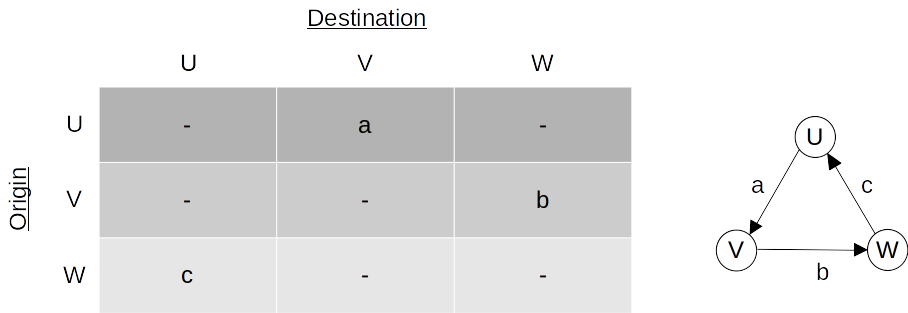
Adjacency Matrix Summary
- addEdge, removeEdge: $O(1)$
- addVertex, removeVertex: $O(n^2)$
- vertex.incidentEdges: $O(n)$
- vertex.edgeTo: $O(1)$
- Space Used: $O(n^2)$